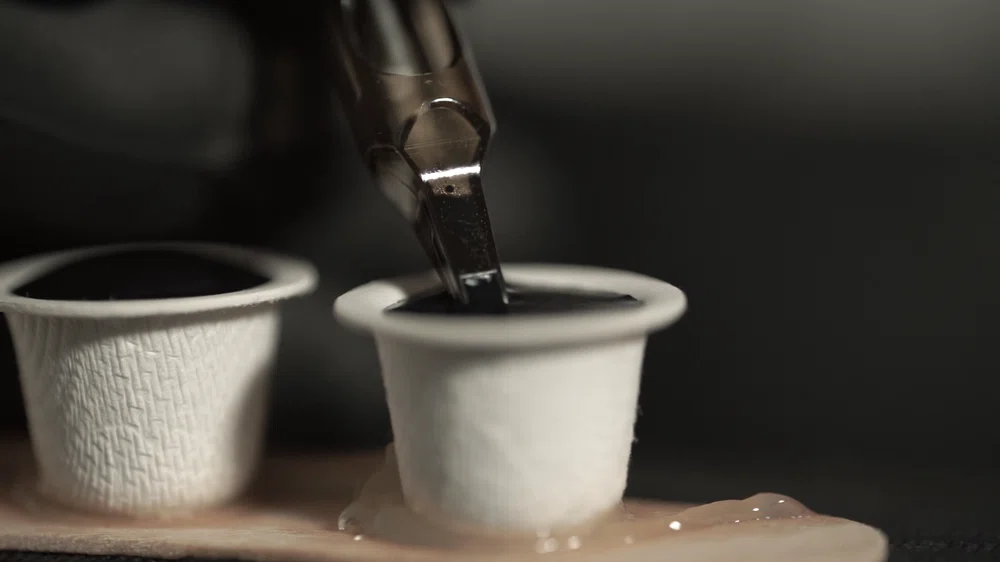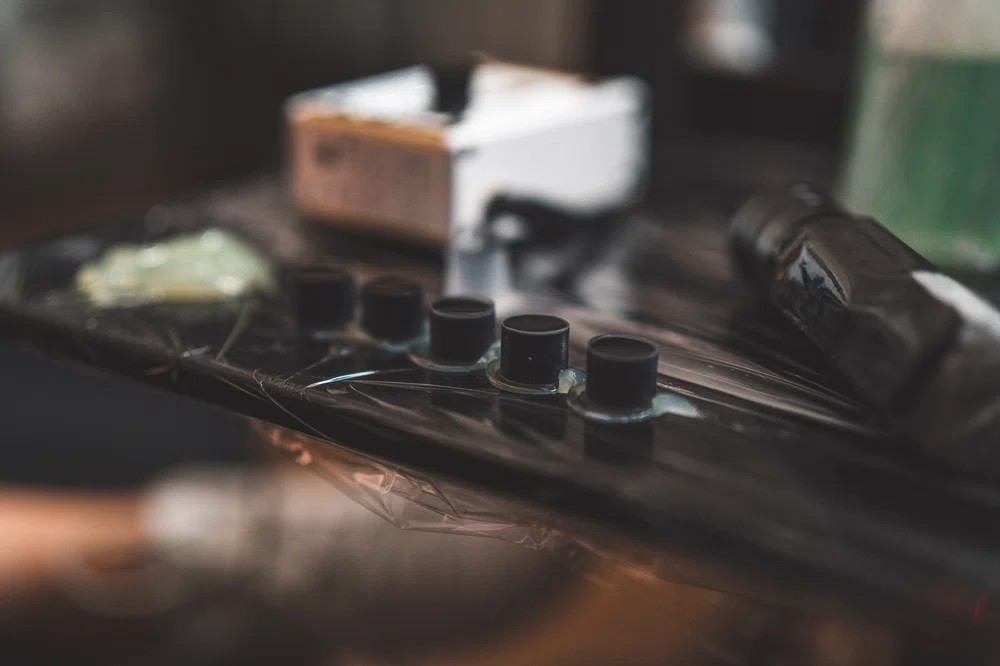Common problems when using dilutions
Tips for solving problems when making dilutions
19 October 2023
Interested in making dilutions for tattooing? Then, this is the perfect post for you, particularly if you work with black ink.
The effects that can be achieved with this technique are truly incredible and versatile, that's why it's usually the preferred option for those dedicated to tattooing. However, like with any other technique, drawbacks are bound to arise.
Here, we provide some solutions to help you achieve great results without giving up. Let's get started.
What are tattoo dilutions, and what are they used for?

In tattoos, dilutions are the process of mixing inks with sterilized distilled water or another diluent to create a specific consistency.
These are used to create different color tones, shades, shading, and other effects.
The dilution process and subsequent application in tattoos is called Grey Wash and is widely used in tattooing, particularly in certain styles. There are several reasons why one might choose to dilute the inks, including:
- Controlling consistency: Thinning the ink can help control consistency and flow, which is helpful for tattoos with fine lines or light shading.
- Create shades and tones of color: Different tones and nuances can be created by diluting the ink, which is very useful and recommended for creating shadows and details.
- Adapt to different tattoo styles: Diluted ink can be used for styles like Realism or Black and Grey. When you need to work in layers, sometimes you have to use inks that generate a rather translucent. This is why diluting the inks is so essential in some styles.
It is worth noting that the process must be done precisely and carefully, as poor dilution can affect the quality and appearance of the tattoo.
Difference between Gray wash and Black and Grey
Although gray Wash and Black and Gray work on shadows and grays to generate certain effects, you should know that these are two different tattoo techniques. Let's see way:
- Gray Wash: this technique specifically refers to diluting black ink with distilled water to create different shades of gray. The effect achieved is a transparent or translucent tone.
It is mainly used to create shadows and gradient effects that give depth and dimension to the design. The final result is a tattoo in soft and delicate shades of gray, similar to the effect of a graphite pencil drawing.
- Black and Gray: This tattooing technique is actually a style in itself. While it occasionally uses dilutions, it primarily relies on a grayscale achieved by mixing black ink with white. This creates a solid or dull shade that is prioritized in the technique.
The result is a tattoo in shades of dark gray and black, which can have a dramatic and realistic effect.
Would you like to learn how to master Black & Gray Technique to achieve realistic tattoos with great depth and volume? In our new Workshop: Black & Gray Technique, Coreh López dives into the different methods and characteristics of this versatile style through a series of practices on synthetic skin; especially for those who want to take their tattooing skills to the next level.
How to dilute the inks?

Although some people believe that there is an exact formula to dilute the inks, this is not entirely true because it will always depend on the techniques you use and the tattoo requirements to be made. Still, we can give you some standard measurements and general recommendations.
First, the materials to make Grey Wash.
The materials used to dilute ink are critical, and there are two ways to do so: sterilized distilled water or prepared diluents.
However, in the experience of many tattoo artists (including ours), there may be better options than prepared diluents. These diluents often contain chemicals such as alcohol and thickeners, which can affect the tattoo's outcome and your overall tattooing experience. More importantly, they can pose a risk to your client's health by potentially generating allergic reactions or irritations.
In addition, pre-diluted inks cannot be customized for each client or tattoo, which can be a disadvantage if you want to achieve certain effects. They may also have a limited range of colors and tones and can be more expensive than undiluted inks.
On the other hand, sterile water is a pure and clean liquid, free of unwanted microorganisms such as bacteria and other impurities that can impact health. Using this element allows for a more fluid consistency in the inks, allowing for better control and results.
That's why we always recommend using sterile water and not another chemical.
Proportions to create the dilutions
As we said before, the proportions will be relative in each case. But we can distinguish at least five measures you can take as a starting point.
At your workstation, place five cups, and mix them as follows:
- 95% distilled water and 5% ink
- 75% distilled water and 25% ink
- 50 and 50 of each product
- 25% distilled water and 75% ink
- 5% distilled water and 95% ink
This way, you can achieve a fairly wide range of dilutions with which you can work comfortably.

A common mistake is not using specific measurements and diluting the ink randomly.
We recommend following a consistent procedure so that, with enough practice, you can dilute to intermediate tones and create more advanced effects. Take it slow and steadily increase the difficulty.
Another typical mistake is not labeling the cups with the proportion of each mixture. We recommend using a marker or pen to write the proportion of the mixture next to each cup.
This way, you can easily distinguish between them and avoid using the wrong ink while tattooing. It may seem trivial, but your entire work can depend on this. So pay attention to it!
Common mistakes when diluting
If you're just starting out using dilutions, you will likely make some of the mistakes we mentioned earlier. However, some problems can appear later, when the tattoo heals.
In general, these inconveniences are caused by poor dilution and misuse of the techniques at the time of tattooing. Some very common ones can be:
- Inconsistent colour: This can result from poor mixing with the diluent and can cause the design to appear undefined and unappealing.
- Skin irritation: If non-sterilized distilled water is used, as mentioned earlier, it can lead to skin irritation and an uneven colour result. It is essential to follow proper safety and hygiene measures to avoid this. In case of any inconvenience, seeking medical consultation is recommended.
- Difficult healing: Improperly diluted ink can be more challenging to remove from the body, which can increase the risk of excessive scarring and, in severe cases, infection.
- Loss of ink quality: Poor dilution can cause the ink to dry and harden in the needle, making it difficult to work with during the tattooing process and leading to a lower-quality tattoo.
For all this, it's a good practice to keep a record of the dilutions used for each tattoo, in case any issues arise later on. This allows you to identify any potential problems with the ink and adjust your dilution process accordingly.
Remember, dilutions can be a great tool in achieving the desired tattoo effect, but it is important to use them correctly and safely to avoid any negative consequences for both you and your clients. To know more about this, read our article about safety and hygiene for tattoos.
Rounding up, using dilutions in tattoos requires time, practice, and experimentation to master. It's important to understand the right proportions of thinners and when to apply them to achieve the desired effects.
It's also crucial to recognize that not all tattoo styles or designs are suitable for gray wash, so experience is essential in making informed decisions.
As with any skill in tattooing, growth and improvement come with dedication, effort, and a desire to learn and improve every day. So, should you want to acquire more tools to achieve this, perhaps you could begin by joining our MasterCourse: Realistic Tattooing, with Coreh López.